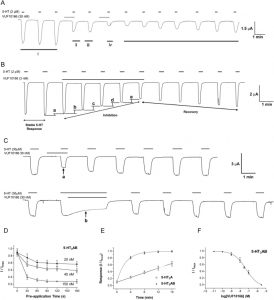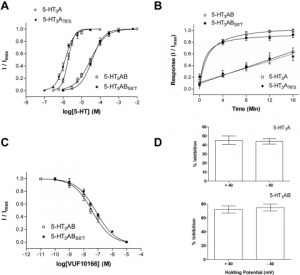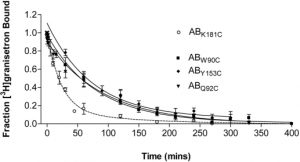
| Size | Price | Stock | Qty |
|---|---|---|---|
| 10mg |
|
||
| 25mg |
|
||
| 50mg |
|
||
| 100mg |
|
||
| 250mg |
|
||
| 500mg | |||
| Other Sizes |
Purity: ≥98%
VUF10166 (VUF-10166; VUF 10166) is a novel, potent and competitive antagonist against serotonin 5-HT3A receptor with important biological activity. Its Ki is 0.04 nM, and it inhibits 5-HT3A.
| Targets |
5-HT3A Receptor ( Ki = 0.04 nM ); 5-HT3 AB ( Ki = 22 nM )
|
||
|---|---|---|---|
| ln Vitro |
|
||
| ln Vivo |
|
||
| Animal Protocol |
|
||
| References |
| Molecular Formula |
C13H15CLN4
|
|
|---|---|---|
| Molecular Weight |
262.74
|
|
| Exact Mass |
262.098
|
|
| Elemental Analysis |
C, 59.43; H, 5.75; Cl, 13.49; N, 21.32
|
|
| CAS # |
155584-74-0
|
|
| Related CAS # |
|
|
| PubChem CID |
24278976
|
|
| Appearance |
Light yellow to yellow solid powder
|
|
| Density |
1.3±0.1 g/cm3
|
|
| Boiling Point |
389.6±42.0 °C at 760 mmHg
|
|
| Flash Point |
189.4±27.9 °C
|
|
| Vapour Pressure |
0.0±0.9 mmHg at 25°C
|
|
| Index of Refraction |
1.637
|
|
| LogP |
2.79
|
|
| Hydrogen Bond Donor Count |
0
|
|
| Hydrogen Bond Acceptor Count |
4
|
|
| Rotatable Bond Count |
1
|
|
| Heavy Atom Count |
18
|
|
| Complexity |
280
|
|
| Defined Atom Stereocenter Count |
0
|
|
| SMILES |
CN1CCN(C2=NC3=CC=CC=C3N=C2Cl)CC1
|
|
| InChi Key |
FFXVTQDGTKEXHF-UHFFFAOYSA-N
|
|
| InChi Code |
InChI=1S/C13H15ClN4/c1-17-6-8-18(9-7-17)13-12(14)15-10-4-2-3-5-11(10)16-13/h2-5H,6-9H2,1H3
|
|
| Chemical Name |
2-chloro-3-(4-methylpiperazin-1-yl)quinoxaline
|
|
| Synonyms |
|
|
| HS Tariff Code |
2934.99.9001
|
|
| Storage |
Powder -20°C 3 years 4°C 2 years In solvent -80°C 6 months -20°C 1 month Note: This product requires protection from light (avoid light exposure) during transportation and storage. |
|
| Shipping Condition |
Room temperature (This product is stable at ambient temperature for a few days during ordinary shipping and time spent in Customs)
|
| Solubility (In Vitro) |
|
|||
|---|---|---|---|---|
| Solubility (In Vivo) |
Solubility in Formulation 1: ≥ 2.5 mg/mL (9.52 mM) (saturation unknown) in 10% DMSO + 40% PEG300 + 5% Tween80 + 45% Saline (add these co-solvents sequentially from left to right, and one by one), clear solution.
For example, if 1 mL of working solution is to be prepared, you can add 100 μL of 25.0 mg/mL clear DMSO stock solution to 400 μL PEG300 and mix evenly; then add 50 μL Tween-80 to the above solution and mix evenly; then add 450 μL normal saline to adjust the volume to 1 mL. Preparation of saline: Dissolve 0.9 g of sodium chloride in 100 mL ddH₂ O to obtain a clear solution. Solubility in Formulation 2: ≥ 2.5 mg/mL (9.52 mM) (saturation unknown) in 10% DMSO + 90% (20% SBE-β-CD in Saline) (add these co-solvents sequentially from left to right, and one by one), clear solution. For example, if 1 mL of working solution is to be prepared, you can add 100 μL of 25.0 mg/mL clear DMSO stock solution to 900 μL of 20% SBE-β-CD physiological saline solution and mix evenly. Preparation of 20% SBE-β-CD in Saline (4°C,1 week): Dissolve 2 g SBE-β-CD in 10 mL saline to obtain a clear solution. View More
Solubility in Formulation 3: ≥ 2.5 mg/mL (9.52 mM) (saturation unknown) in 10% DMSO + 90% Corn Oil (add these co-solvents sequentially from left to right, and one by one), clear solution. |
| Preparing Stock Solutions | 1 mg | 5 mg | 10 mg | |
| 1 mM | 3.8060 mL | 19.0302 mL | 38.0604 mL | |
| 5 mM | 0.7612 mL | 3.8060 mL | 7.6121 mL | |
| 10 mM | 0.3806 mL | 1.9030 mL | 3.8060 mL |
*Note: Please select an appropriate solvent for the preparation of stock solution based on your experiment needs. For most products, DMSO can be used for preparing stock solutions (e.g. 5 mM, 10 mM, or 20 mM concentration); some products with high aqueous solubility may be dissolved in water directly. Solubility information is available at the above Solubility Data section. Once the stock solution is prepared, aliquot it to routine usage volumes and store at -20°C or -80°C. Avoid repeated freeze and thaw cycles.
Calculation results
Working concentration: mg/mL;
Method for preparing DMSO stock solution: mg drug pre-dissolved in μL DMSO (stock solution concentration mg/mL). Please contact us first if the concentration exceeds the DMSO solubility of the batch of drug.
Method for preparing in vivo formulation::Take μL DMSO stock solution, next add μL PEG300, mix and clarify, next addμL Tween 80, mix and clarify, next add μL ddH2O,mix and clarify.
(1) Please be sure that the solution is clear before the addition of next solvent. Dissolution methods like vortex, ultrasound or warming and heat may be used to aid dissolving.
(2) Be sure to add the solvent(s) in order.
 |
|---|
 |
 |